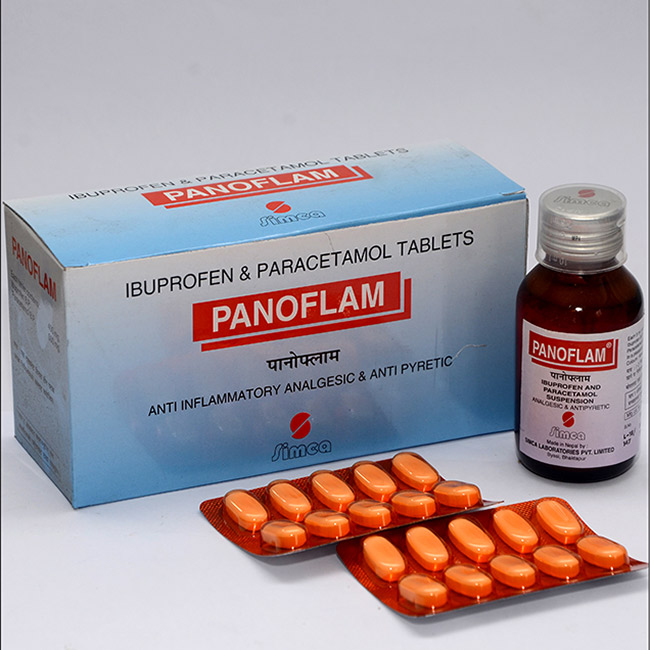Panoflam
Generic composition
- For tablet– Ibuprofen 400mg and Paracetamol 500mg Tablets
- For Suspension: Ibuprofen 100mg and Paracetamol 125mg / 5ml
General Introduction
Inflammation is one of the body’s prime responses to any injury or disease. Of the five classical symptoms of inflammation (redness, heat, pain, edema and functional limitations), the most common would be pain. Since inflammation and pain co-exist in many situations, the scope exists across specialties for the use of a potent anti-inflammatory-analgesic combination.
Therapeutic category
- Non-steroidal Anti-inflammatory drugs (NSAIDs)
Dosage forms available
- PANOFLAM Tablets
- PANOFLAM Suspension
Mode of action
Non-Steroid Anti-inflammatory drugs like Ibuprofen reduce inflammation by inhibition of prostaglandin synthesis at the site of inflammation while Paracetamol acts on the CNS to produce analgesia and anti-pyretic effect; has negligible anti-inflammatory action in therapeutic doses.
Pharmacokinetics
Ibuprofen is rapidly absorbed. The bioavailability of the drug is minimally altered by the presence of food.
Uses
- Rheumatic conditions such as rheumatoid arthritis, osteoarthritis, ankylosing spondylitis.
- Low back pain.
- Infective inflammatory conditions such as tonsillitis, pharyngitis, otitis media, pharyngitis, and inflammatory conditions in gynecology, urology
- Reduce mild to moderate pain associated with migraine, headache, backache, period (menstrual) pain, dental pain
Dosage
- Adults and children (12 years and over): One tablet every 8 hourly.
- Children (under 12 years): Suspension Half measure (5 ml) to one measure (10 ml) thrice daily
Contraindications
Ibuprofen is contraindicated in patients with peptic ulcers, bronchial asthma, recent GI bleeding and in known hypersensitivity to the drug. Paracetamol is contraindicated in patients with hepatic dysfunction.
Adverse Reactions
Ibuprofen: Dyspepsia, heart burn, GI bleeding, rash, asthmatic attacks, thrombocytopenia, drug induced ulcer, drowsiness, hepatic necrosis, diarrhora, headache, dizziness
Paracetamol: In recommended doses, the side effects of paracetamol are mild to non-existent
Drug Interactions
Ibuprofen:
- Ibuprofen antagonizes the effects of furosemide and thiazides.
- Aspirin displaces the Ibuprofen from binding sites.
- Increases risk of GI ulceration and bleeding with anticoagulants.
- Ibuprofen increases the risk of methotrexate toxicity and lithium toxicity.
Paracetamol:
- Paracetamol increases the risk of liver damage in chronic alcohlolics.
Precautions
The drug should be used with special precaution in bronchial asthma,renal orhepatic disorders, bleeding disorders, Patients on anticoagulants, pregnancy and lactation.


